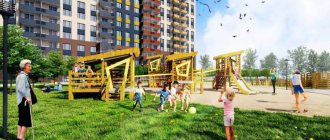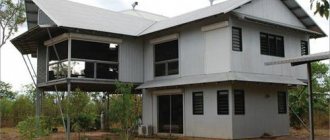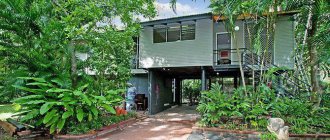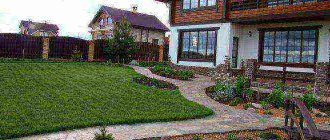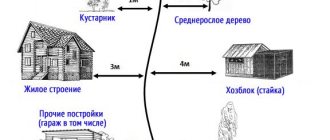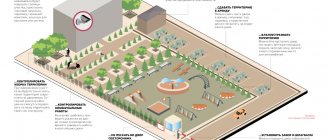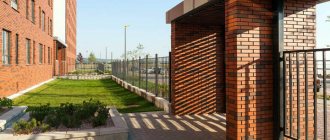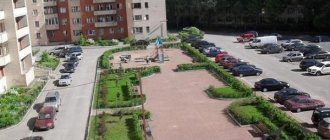Apartment
23
When purchasing an apartment, its owner is sure that all rights to the purchased meters belong exclusively to him. But few people think about what happens to the land and the real estate located on it, which is located next to the apartment building.
The adjacent territory is the territory adjacent to a residential building, defined by land management and urban planning documentation within a plot of land of a certain area.
It may contain various structures and non-residential premises necessary to meet the household needs of the residents of this house. Many people are interested in the question of how many meters is the adjacent area of an apartment building in 2021? Read more about this below.
Home improvement and local area
There are no specific standards regulating the exact size of the local area. On average, for an apartment building this equates to 3-6 meters (maybe more).
According to Art. 36 Housing Code of the Russian Federation, the local area includes :
- blind areas (waterproof coverings located around the building);
- driveway, sidewalk, planting strip along the house, as well as the one located near the facade without entrances (its purpose is to provide passage for fire trucks);
- children's playgrounds, sports grounds, as well as those pedestrian paths (paths) that connect these objects to each other;
- areas where waste bins are located;
- plots of land under non-residential commercial buildings and structures;
- parking lots where the cars of residents of an apartment building are parked;
- exits, entrances to underground garages and parking lots.
Elena Shereshovets spoke about the formation and maintenance of the MKD land plot
On the first day of the online seminar, the Head of the Expert Council of the P1 Association, Elena Shereshovets, examined what changes have occurred in the legislation in the field of land and real estate in 2021. We also discussed topics such as:
- formation of a site for an apartment building;
- protection of the rights of premises owners during its registration;
- transfer of ownership of the site.
Among these issues, we discussed the topic of responsibility for the maintenance of the land.
Watch the demo on the YouTube channel of the P1 Association ➡️
Registration of property
The only legally accessible and legal option for privatizing the adjacent territory today is the organization of condominium associations (associations of co-owners of an apartment building). It is important to understand that after drawing up the agreement, it does not become the property of the condominium association, but belongs to all co-owners of the apartment building in equal shares.
The condominium association is a legal entity, a non-profit organization, the main objectives of which are to improve the quality of provided public services, manage an apartment building, and rationally operate shared facilities for residents.
The sequence of transferring land into the ownership of condominiums:
- At a meeting of residents, an appropriate decision is made on the privatization of the land around the house;
- Next, you should contact Rosreestr with an application to register ownership;
- When the permission to allocate a land plot and the corresponding technical specifications are ready, you need to go to the land management organization with a package of documents.
How to hold a general meeting of residents in 2021?
What documents will be required:
- certificate of state registration of condominiums;
- the charter of this organization;
- certificate of inclusion in the All-Russian Classifier of Enterprises and Organizations (OKPO);
- technical passport for an apartment building;
- extract from the state register of ownership;
- decision of the members of the condominium association to transfer the adjacent territory to private use;
- land boundary plan.
In turn, the land management organization, based on the land division project and the documents provided by the condominium association, prepares a site allocation project. Next, the city council must decide to transfer the territory near the house to the ownership of the residents of the apartment building and approve the corresponding project.
Based on the results of all the decisions made, the boundaries of the site are drawn to the area, after which a state act on the ownership of residents of the land adjacent to the house is drawn up and entered into the Unified State Register of Rights to Real Estate.
Registration of condominiums and selection of relevant documentation are energy- and financially-intensive activities. However, this procedure has several advantages:
- Residents can independently dispose of the corresponding plot of land, monitor (adjust) the amount of payment for cleaning the local area.
- Privatization allows you to avoid unwanted buildings in the relevant area and use the territory for the needs of the residents of the apartment building.
Basic Concepts
The adjacent territory is a plot of land that borders a building and is used by the owner of the building to meet his needs.
In the legislation of the Russian Federation there is no precise definition of the local area of a private house. Usually it refers to a part of the land near the yard of the house owner, which he needs to maintain his plot.
Mostly, owners of private houses completely enclose their property with a fence. It is a mistake to believe that the territory behind the fence has no owner. This land belongs to the municipality. In order to obtain the right to use this land in their own interests or dispose of it, the owner of a private house must justify his easement.
All legal issues are regulated by the Constitution of the Russian Federation, the Civil Code, the Land Code, the Law “On the State Real Estate Cadastre”, cadastral and technical documents for land.
How to fence an area
The adoption of a conclusion on the installation of a barrier, the installation of blocks or a protective fence falls within the competence of the general meeting of homeowners in this high-rise building (MCD):
- If apartment owners or their agents took part in the consultation, and the issue was decided by more than fifty percent of the total votes, then the meeting has the legal capacity to organize such decisions.
- After which it is necessary to design a design for the fence structure and coordinate it with the police, the Ministry of Emergency Situations and the 03 service, in order to guarantee independent passage of cars in the prescribed emergency areas.
- In addition, residents have full authority to block areas of public use: embankments, roads, through courtyard passages, green areas. All this is possible taking into account the rights and legitimate needs of the population, nearby buildings, owners of neighboring plots and other nearby objects that may need this common area to provide access or passage.
The design, installation and ongoing repairs of fencing structures are carried out at the expense of the personal money of the owners of high-rise apartments. Subsequently, upon completion of construction, the fence will become the single shared property of absolutely all owners of premises in the building.
Information
The legislative documents on which all calculations are carried out today have become irrelevant. The head of the executive branch entrusted the creation of a normative act with new principles for the formation of local areas, however, even today the territory is still the subject of speculation and arbitrariness.
We have tried to describe in sufficient detail in this article what the adjacent territory of an apartment building is and all the main nuances associated with this issue; this information will help owners avoid various funny situations and protect themselves from lawlessness. Next, I suggest watching an interesting video on the topic: how many meters is the adjacent area of an apartment building.
Who is the owner
According to ordinary logic, this territory must be the property of the residents of the building built on it, since the adjacent land with its front gardens, benches and sports grounds was originally intended for the entertainment of the people living in the house. Article 16 of the Federal Law on Housing Code No. 189 states:
- The territory around the house, on which a multi-storey residential building and other objects and structures included in this building are built, which are associated with the territory and created before the entry into force of the law and in relation to which government price accounting was carried out, is freely transferred to a single (collective) shared property apartment owners.
- The site on which a multi-apartment residential building and other objects and structures included in its structure that are associated with the territory are located are the aggregate (collective, common) shared property of the owners (copyright holders) of the apartments.
- If the territory on which a multi-apartment residential building and other objects and structures included in the structure of such a structure that are associated with the territory are located was not created before the implementation of the residential complex, then each owner has the right to make a corresponding application to the national authorities or regional authorities with request for the creation of a land zone.
Maintenance Responsibilities
The parameters of the adjacent land - area, limits - are displayed in the cadastral passport. This information is the basis for calculating the costs of management companies for cleaning this place. If the area of the local area is not properly designed, then responsibility for its maintenance rests with the municipal administration.
Correctly managing not only the object itself, but also the land adjacent to it, you can significantly reduce costs and increase the comfort of living. Each locality develops its own set of rules. However, they always contain universal components created on standard sanitary standards. The main work consists of:
- Cleaning the local area. Snow is unconditionally removed from access roads and sidewalks, entrances and address signs are cleaned.
- Work in the field of formation of areas where children rest.
- Fencing the area or its components. The basics are to take into account the range of interests of residents in nearby houses.
- The yard arrangement of parking for motorists is extremely important; many factors depend on where personal vehicles are located.
- Organize the operation of waste disposal sites.
- Planting and processing. It is necessary to form lawns, plant bushes and trees, and landscape the area.
- Erect the necessary buildings, install fences, carry out their scheduled repairs.
Almost everything depends on how the owners themselves relate to this, to what extent they proactively look after their own home and the surrounding area is always in a tidy condition. It is very important to fulfill the requirements for landscaping, at least to a small extent, and in most cases, developers are responsible for performing one-time work.
Any additional work as part of landscaping the yard
In addition to the basic and standard services for landscaping the local area of a residential building (laying out flower beds, planting plants, lawn care), Cleaning for Business employees are also always ready to perform additional tasks.
For example, work can be done to paint fences and barriers, install or dismantle them, as well as arrange eco-parking for cars in the yard. Cleaning for Business cares about the ecology of the city, so it carries out such work with pleasure. Preparing a site for eco-parking in the courtyard of a residential building
Parking questions
The procedure for organizing parking and parking zones in courtyards is always the main criterion for design. Already during the design period of the building, the order of location of the packing areas is envisaged, which is used when creating a parking lot in the yard and the surrounding area. Owners can use these principles at the stage when they are drawing up a plan for the local area of an apartment building (in accordance with SNiP) and create additional parking lots, arrangement of personal garages, but the following should be taken into account:
- the distance from a parking lot accommodating up to ten cars to the building of a residential building should be at least ten meters, but to garages it can be a quarter more distance;
- it is possible to install garages on local land only if the exits from these garages do not face the buildings;
- The presence of an open parking lot is permitted, which can accommodate up to fifty vehicles. When we talk about parking spaces or garages with continuous wall fencing, in this case their capacity can be increased up to one hundred cars. If there is still not enough space, then it is possible to rent an additional area.
Residents can file a complaint if the parking lot provokes various obstacles and limits the residents’ opportunities to the appropriate governing bodies, this is the municipal or district city. administration, fire supervision, sanitary control services. Whenever disputes arise about parking cars in yards, you first need to examine the district regulations.
Traffic rules
The adjacent territory, in addition to these laws, is also regulated by traffic regulations, which delineate zones where parking is generally not permitted:
- The rules strictly prohibit idle time in the courtyards of vehicles with the engine running for more than five minutes, unless the necessary loading and unloading operations are performed or passengers are not boarded and disembarked. The importance of this principle increases with the arrival of winter time, if the driver needs to warm up the car;
- the adjacent territory of an apartment building establishes standards for parking and leaving cars on sidewalks, lawns, walkways and where transport will impede the movement of pedestrians or other vehicles (bicycles, scooters, etc.);
- It is prohibited to erect barriers independently, without permission, and thus secure parking spaces;
- It is not allowed to interfere with the passage and passage into the yard, or park the car at a distance closer than five meters. from trash cans;
- further, the adjacent territory of the apartment building prohibits the parking of trucks (over three and a half tons) outside specially designated areas; such a zone may be the territory paid for by a shopping center and industrial buildings located near it;
The owner of the car who mistakenly delivered his own car will have to pay the penalty. If such a situation with a would-be driver is repeated more than once, traffic police officers will raise the issue of depriving the offender of his driver’s license.
